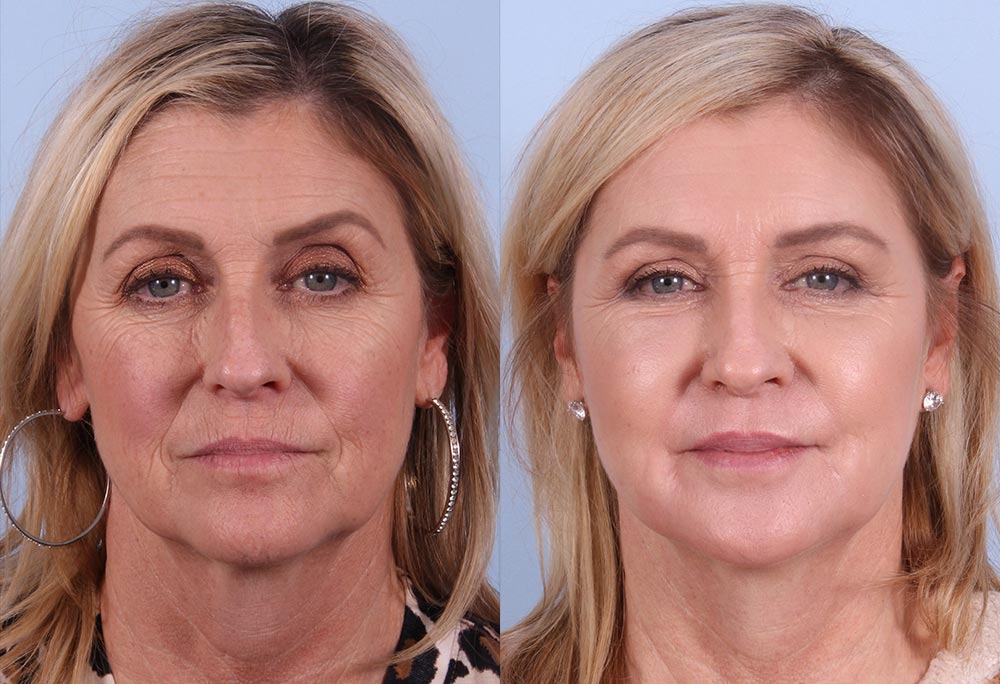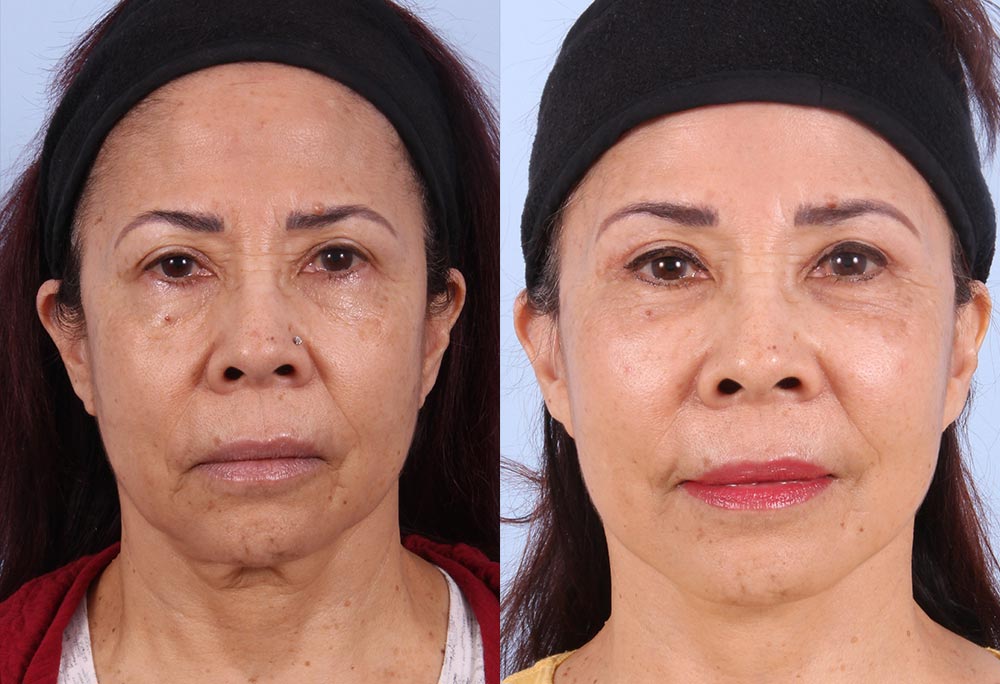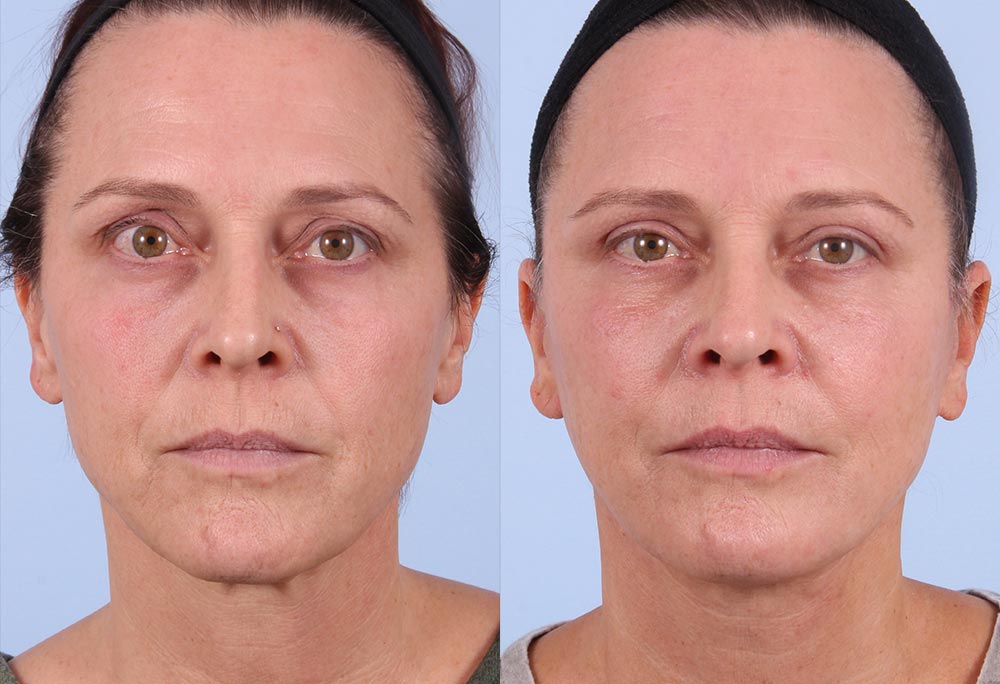
You might think that wrinkles are the most apparent signs of aging, but volume loss in the face can actually make you look older—while paving the way for wrinkles. As we age, we naturally lose the necessary facial fat that makes us look young and healthy. Facial fat loss is what can lead to hollowness around the eyes, temples, and cheeks, and make skin sag and less tight. Fortunately, there is a “permanent” way to restore facial volume with a facial fat transfer.
RefinedMD takes a holistic approach to anti-aging, combining world-class facial plastic surgery performed by the renowned double board certified Dr. Sudeep Roy with the best in non-surgical dermatological treatments. Patients enjoy the benefits of a “one-stop” experience where they can have access to top cosmetic surgeons and aesthetician practitioners. A comprehensive, personalized approach is what ensures you look and feel your best for life.
How Fat Transfer Works
There are a few ways to lift facial tissue, including dermal fillers and facelifts. However, some patients prefer to avoid invasive surgeries and opt for a permanent solution that dermal fillers cannot provide. Facial fat transfers can be an effective way to restore your face to its youthful appearance, or it can be a fantastic complement to surgical results. For many years, facial implants were the only way to achieve the results of facial fat transfers offer. However, they can be costly and limiting. Implants can move, extrude, and there is an increased risk of infection with this more invasive procedure. A facial fat transfer is Dr. Roy’s recommended approach for anyone looking for natural, stunning results or to boost the effect of surgical results.
Fat can be a great thing. With an autologous (your own tissue) fat transfer, the fat is harvested from other parts of the body—usually the tummy—and expertly injected into key areas of the face. The results are long-term increased volume and better contouring. Facial fat transfers are much less invasive and more cost-effective than many other solutions. Keep in mind that a percentage of fat in these transfers is not expected to “take,” which means a little more fat is often injected than will be needed in the transplant site. That’s a bonus for patients who want to look and feel their best!
Fat is manually harvested from the donor site with liposuction tools, then processed in a filtration system that purifies it. Once the fat is optimized, it’s injected into the target sites. The injection sites are very small to ensure no scarring and minimal recovery time.
Anesthesia During a Fat Transfer and Recovery Time
The procedure is relatively quick. Depending on the amount of fat transfer, local anaesthetic, and either oral or IV sedation is required. Since the injection sites are minimally invasive, there is no need for stitches, staples, or even any dressings post-surgery.
Most patients fully return to their daily lives between 10 – 14 days after the procedure. There is typically some swelling and bruising during this period. Light activity can be resumed at two weeks, and high-impact activities at three weeks. Patients see full results at three months but can enjoy a fantastic preview about two weeks after the surgery.
However, since every procedure is customized (and every person is unique), there can be some variation in recovery times. Avoid touching the injection site or vigorous activity that may involve the injection site (such as immediately continuing your career as a professional flutist after fat transfer to the lips) to allow safe, quick healing. Your exact recovery plan will be carefully detailed during your consultation and appointment with Dr. Roy. However, compared to many other facial plastic surgeries, fat transfer requires a relatively quick recovery.
Facial Fat Transfer Candidates and Frequently Asked Questions
Ideal Candidates for Fat Transfer
Most people lose volume with age, or simply due to genetics. Some of the most popular places for fat transfers are the forehead, brows, temples, cheeks, and around the jawline, although some patients benefit from fat transfer in less common areas. The ideal candidate for a fat transfer is someone with excess fat in some areas and who are looking for a permanent solution. If you’re uncertain whether a fat transfer is right for you and would rather “test out” volume restoration, you might want to consider a dermal filler first.
Procedures to Complement a Fat Transfer
Dermal fillers are a fantastic alternative or “starter” to a fat transfer for those who aren’t certain they want permanent volume restoration just yet. However, if you do know you want the immediate and permanent results a fat transfer provides, you can enhance your results with complementary surgical procedures. Many patients pair a fat transfer with a facelift for a more dramatic, yet still natural, youthful effect. Tightening of the mid and lower face, as well as the neck, can make you look years and even decades younger. However, it can also further highlight volume loss. A fat transfer with a facelift is a very natural pairing. More targeted lifts, such as an eyelid lift (blepharoplasty) or brow lift, can also complement fat transfers.
A fat transfer is already a relatively minor surgery, and a lot of patients prefer to avoid more invasive surgeries. When this is the case, RefinedMD offers a variety of non-invasive treatments that complement a fat transfer. A chemical peel can serve as an alternative to a facelift, making clients look years younger.
Fat Transfer FAQs
What kind of anesthesia is used for facial fat transfer surgery?
Dr. Roy typically performs facial fat transfer surgery under IV sedation at an accredited outpatient surgical center, although partial fat transfers may be done in the office under local anaesthetic and minimal oral sedation. General anesthesia is not required.
How does Dr. Roy perform facial fat transfer surgery?
After anesthesia is induced and the donor site cleaned, fat is harvested from a part of the body that naturally contains more fat, often times the abdomen or upper thigh, using gentle, manual suction (to preserve the viability of the fat). The fat is then purified in a specialized fat processing system to yield high-quality fat for the transfer. A very fine blunt cannula (hollow tube) is then used to transfer this fat into parts of the face that appear hollow and require more volume. It is usually necessary to slightly over-fill the treated areas to compensate for some natural absorption of the transferred fat that occurs. This may cause the face to appear a little more puffy/swollen temporarily during the recovery.
Where are the incisions for facial fat transfer surgery and will there be visible scars?
The only incisions are at the harvest site (one on the abdomen, two if using each thigh), and these are generally less than half a centimeter and heal inconspicuously. The small poke holes used to introduce the blunt injecting cannulas for the transfer itself generally heal very quickly and are undetectable a few days after surgery.
Will facial fat transfer surgery be painful?
Pain or discomfort is typically very mild after facial fat transfer procedures. Due to anesthesia used, the patient does not feel any discomfort during the procedure itself.
What is recovery like after facelift surgery?
No post-operative dressings or drains are used after facial fat transfer procedures. Overfilling, however, is often necessary and for this reason the face may temporarily appear puffy or swollen for a period of 10-14 days. Minor bruising or redness may also occur for this period.
How much time off work will I need after facial fat transfer surgery?
While there are no facial incisions involved in fat transfer, swelling does limit return to social activities to 10-14 days. Most patients will take 1-2 weeks off work depending on desire to conceal the procedure from co-workers.
When can I exercise after facelift surgery?
Light walking can be resumed after about 1 week after facial fat transfer surgery. Low impact activities (such as elliptical, weight lifting, exercise bike etc) can begin after 2 weeks while high impact activities need to be restricted for 3 weeks.
Contact Dr. Sudeep Roy Today
We tend to focus on treating our wrinkles, but a facial fat transfer can often address multiple signs of aging. It can restore skin to its taut, youthful appearance while filling out many fine lines and wrinkles. When you’re considering a rejuvenation treatment, it’s important to address the root issues to achieve the results you deserve. Dr. Roy customizes every treatment plan to the patient’s comprehensive goals, and what many patients want isn’t just a wrinkle treatment but a full facial rejuvenation. Is a facial fat transfer for you? Contact Dr. Roy now for a consultation and learn more about your options. Call RefinedMD, at (408) 831-3921 and schedule your consultation today.



